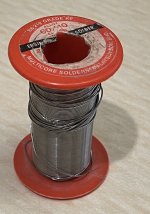Associate
- Joined
- 8 Jul 2010
- Posts
- 832
- Location
- Staffordshire
TL;DR I'm after some flux paste for use with electronics. I'd prefer something that's easy to work with / doesn't require scraping and diluting with IPA, and if possible... I'd like to keep it under £5. And the cherry on the cake would be not having to wait a month for it to come from China.
I've finally decided to get myself a soldering station (after a couple of bodge jobs with a back of the garage, old as the hilss iron). I've got the soldering station (with sponge and brass wool), I've got the rosin core solder, I've got some solid core 22awg wire from the 'bay, and I've got some 2mm wick... all I need now (I think) is the flux but I'm kind of struggling to see the wood for the trees. There's so much available, ranging in price from a couple of quid to a tenner or more, and it's sometimes hard to tell if a given product is forelectronics or for plumbing/brazing (no thanks to amazon for recommending the latter when buying supplies for the former). The results I'm getting that are specifically for SMD work, are solid blocks of rosin rather than paste. I'm also note sure whether it's worth spending £10 when there might be £2 options out there that will get the job done.
I've finally decided to get myself a soldering station (after a couple of bodge jobs with a back of the garage, old as the hilss iron). I've got the soldering station (with sponge and brass wool), I've got the rosin core solder, I've got some solid core 22awg wire from the 'bay, and I've got some 2mm wick... all I need now (I think) is the flux but I'm kind of struggling to see the wood for the trees. There's so much available, ranging in price from a couple of quid to a tenner or more, and it's sometimes hard to tell if a given product is forelectronics or for plumbing/brazing (no thanks to amazon for recommending the latter when buying supplies for the former). The results I'm getting that are specifically for SMD work, are solid blocks of rosin rather than paste. I'm also note sure whether it's worth spending £10 when there might be £2 options out there that will get the job done.



